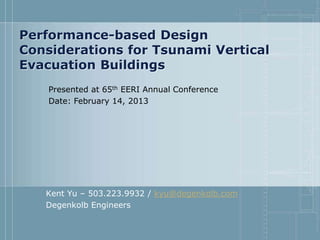
Performance-based Design Considerations for Tsunami Vertical Evacuation Buildings - Kent Yu
- 1. Performance-based Design Considerations for Tsunami Vertical Evacuation Buildings Presented at 65th EERI Annual Conference Date: February 14, 2013 Kent Yu – 503.223.9932 / kyu@degenkolb.com Degenkolb Engineers
- 2. Overview Oregon Tsunami Exposure Tsunami Vertical Evacuation Building Debris Types Performance Objectives Design Loads Closing Thoughts
- 3. Cascadia Subduction Zone Earthquake Oregon is a geologic mirror-image of Northern Japan. In both places, the Pacific Ocean floor is sliding beneath the adjacent continents along giant faults called subduction zones. (Graphic by Dan Coe, DOGAMI)
- 4. Cascadia Subduction Zone Earthquake
- 5. Oregon Tsunami Exposure (Source: Nate Wood/2007, USGS)
- 6. Tsunami Simulation at Cannon Beach Elevation vs. Time 18 Depth (Location 2) Depth (Location 4) 15 12 Depth (ft) 9 6 3 0 1000 1500 2000 2500 3000 3500 4000 Time (s) Velocity vs. Time (+ inland) 15 10 Velocity (ft/s) (+ Inland) 5 0 -5 Velocity (Location 2) -10 Velocity (Location 4) -15 1000 1500 2000 2500 3000 3500 4000 Time (s) (Source: DOGAMI SP 41, 2009) (Source: YouTube, Onagawa Tsuanmi)
- 7. Oregon Tsunami Vulnerabilities City of Seaside with 83% of its population, 89% of its employees and almost 100% its critical facilities in the tsunami inundation zone (Source: Oregon Resilience Plan)
- 8. Minamisanriku High Ground Residential Residential Neighborhood Neighborhood EOC Hospital Police HQ Department Store Multi-Family Housing & Tsunami Vertical Evacuation Building (Source: Oregon Resilience Plan)
- 9. MSR: EOC
- 10. MSR: Hospital
- 12. Debris and Structural Damage > NSF Field Team: Clay Naito (Lehigh U.) Dan Cox (OSU) Kent Yu (Degenkolb) > Tsunami Borne Debris Wood Debris Boats/Ships Vehicles/Cars Shipping Containers Building Components
- 13. Wood Debris Photo: Y. Okuda BRI Japan Photo: Y. Okuda BRI Japan
- 15. Boat/Ship Debris
- 16. Shipping Container Debris Sendai, Japan
- 19. Impact Cases
- 20. Wood Construction • 4 m Inundation Threshold (MLITT, Japan)
- 21. Steel Building
- 24. US Tsunami National Standard > Hawaii Tsunami Code > FEMA P646 Tsunami Vertical Evacuation Building (2008, 2012) > ASCE Tsunami Loading and Effects Committee Chaired by Gary Chock > ASCE 7 Chapter 6 to be published in ASCE 7-16 2018
- 25. Lessons Learned: Evacuation Structure Tall Enough? (Source: P646 & Gary Chock, 2012 )
- 26. Design Performance Objectives > Performance objective • Immediate Occupancy for MCE (comparable or better than hospitals) • Little Residual deformations after EQ • Current Code Design (with I =1.5) may not be adequate (Thomas et al. 2012, 15WCEE)
- 27. Design Loads > Dead Loads Self Wt of Structure (beams, columns, slabs) Cladding/Partitions Mechanical/electrical/plumbing Flooring/Roofing > Live Evacuation Zone (100psf) • Non-Reducible
- 28. Design Loads > Seismic Loads 0.6 0.4 Acceleration (g) 0.2 0 In Oxnard from 1994 -0.2 0 10 20 30 40 50 60 Northridge EQ -0.4 -0.6 Time (sec.) 0.4 N-S Acceleration (g) 0.2 0 0 20 40 60 80 100 120 140 160 180 200 -0.2 -0.4 Time (sec.) In Ica from 2007 Peru M8 EQ (105 km from > Structural Verification epicenter)
- 29. Tsunami Effects Elevation vs. Time 18 Depth (Location 2) Depth (Location 4) 15 12 Depth (ft) 9 6 3 0 1000 1500 2000 2500 3000 3500 4000 Time (s) Velocity vs. Time (+ inland) 15 10 Velocity (ft/s) (+ Inland) 5 0 -5 Velocity (Location 2) -10 Velocity (Location 4) -15 1000 1500 2000 2500 3000 3500 4000 Time (s)
- 30. Design Loads > Tsunami Loads Impulse Load • Leading edge of wave Hydrodynamic Load • Drag on Columns Impact Loads • Impact of large objects (log, car, or/and container) Damming Between Columns Buoyancy Forces
- 31. Structural Layout Consideration > Design Vertical Layout to Minimize Tsunami Loads > Breakaway Walls > Prevent Progressive Collapse > Multiple Line Defense
- 32. TEB Structural Design > Foundations • Scouring Issue • Piles to provide structural support • Grade beams to interconnect pile caps • Slab-on-grade tied to grade beams (Source: Cannon Beach City Hall White Paper, 2009)
- 33. Tsunami Vertical Evacuation Refuge Japan Proposed in Oregon Japan Under construction in Thailand 3/4/2013Yumei
- 34. Lessons Learned: Why People Don’t Evacuate?
- 35. Closing Thoughts > Assess Tsunami hazard accurately > Develop Tsunami Inundation Maps and Provide Useful Engineering Parameters Relevant To Structural Design and Assessment > Sound Planning based on Response and Recovery (schools, critical facilities) > Build Vertical Evacuation Structures as appropriate > Education, Training, and Practice
